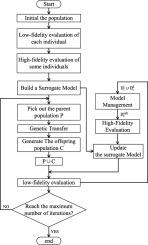Applied Soft Computing ( IF 7.2 ) Pub Date : 2021-07-15 , DOI: 10.1016/j.asoc.2021.107713 Jianzhao Li 1 , Hao Li 1 , Yiting Liu 1 , Maoguo Gong 1

|
Endmember extraction plays an indispensable role in hyperspectral image processing, which is also an important step to decompose the mixed pixels in spectral unmixing. Most of the existing methods based on the principle of convex geometry and intelligent optimization algorithms have achieved an excellent result, but they also suffer from the influence of outliers and expensive computation respectively. Furthermore, it is difficult to determine the number of endmembers in a hyperspectral image without any prior conditions. In order to alleviate these problems, we propose a multi-fidelity evolutionary multitasking optimization framework for hyperspectral endmember extraction in this article. In the proposed framework, multiple tasks to extract different numbers of endmembers are uniformly coded into a single population, aiming to process these similar tasks simultaneously with the implicit genetic transfer. Accordingly, our proposed algorithm is capable of extracting the best endmember set within a certain range of the number of endmembers without any prior knowledge. In addition, an ensemble surrogate model is firstly built to approximate the high-fidelity fitness with the low-fidelity fitness in endmember extraction, which greatly alleviates the time-consuming problem of individual evaluation. The experimental results on the simulated and the real hyperspectral data demonstrate the effectiveness of the proposed framework. The accuracy and the efficiency of endmember extraction are greatly improved compared with other classic endmember extraction methods.
中文翻译:

用于高光谱端元提取的多保真进化多任务优化
端元提取在高光谱图像处理中起着不可或缺的作用,这也是光谱解混中分解混合像素的重要步骤。现有的大多数基于凸几何原理和智能优化算法的方法都取得了很好的效果,但它们也分别受到异常值和昂贵计算的影响。此外,在没有任何先验条件的情况下,很难确定高光谱图像中端元的数量。为了缓解这些问题,我们在本文中提出了一种用于高光谱端元提取的多保真进化多任务优化框架。在提议的框架中,提取不同数量端元的多个任务被统一编码到一个群体中,旨在与隐式遗传转移同时处理这些相似的任务。因此,我们提出的算法能够在没有任何先验知识的情况下,在端元数量的一定范围内提取最佳端元集。此外,首先建立了集成代理模型,在端元提取中用低保真适应度逼近高保真适应度,大大缓解了个体评估的耗时问题。模拟和真实高光谱数据的实验结果证明了所提出框架的有效性。与其他经典的端元提取方法相比,端元提取的准确性和效率有了很大的提高。我们提出的算法能够在没有任何先验知识的情况下,在端元数量的一定范围内提取最佳端元集。此外,首先建立了集成代理模型,在端元提取中用低保真适应度逼近高保真适应度,大大缓解了个体评估的耗时问题。模拟和真实高光谱数据的实验结果证明了所提出框架的有效性。与其他经典端元提取方法相比,端元提取的准确性和效率大大提高。我们提出的算法能够在没有任何先验知识的情况下,在端元数量的一定范围内提取最佳端元集。此外,首先建立了集成代理模型,在端元提取中用低保真适应度逼近高保真适应度,大大缓解了个体评估的耗时问题。模拟和真实高光谱数据的实验结果证明了所提出框架的有效性。与其他经典端元提取方法相比,端元提取的准确性和效率大大提高。首先建立集成代理模型,在端元提取中用低保真适应度逼近高保真适应度,大大缓解了个体评估耗时的问题。模拟和真实高光谱数据的实验结果证明了所提出框架的有效性。与其他经典的端元提取方法相比,端元提取的准确性和效率有了很大的提高。首先建立集成代理模型,在端元提取中用低保真适应度逼近高保真适应度,大大缓解了个体评估耗时的问题。模拟和真实高光谱数据的实验结果证明了所提出框架的有效性。与其他经典端元提取方法相比,端元提取的准确性和效率大大提高。











































 京公网安备 11010802027423号
京公网安备 11010802027423号